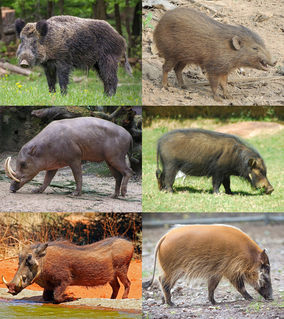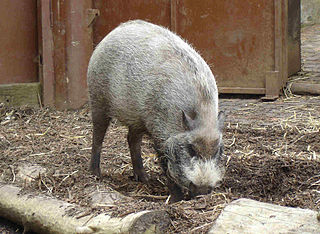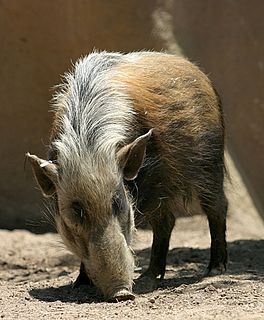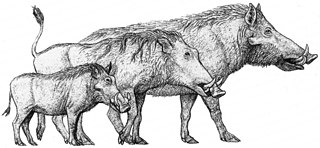
Suidae is a family of artiodactyl mammals which are commonly called pigs, hogs, or boars. In addition to numerous fossil species, 18 extant species are currently recognized, classified into between four and eight genera. Within this family, the genus Sus includes the domestic pig, Sus scrofa domesticus or Sus domesticus, and many species of wild pig from Europe to the Pacific. Other genera include babirusas and warthogs. All suids, or swine, are native to the Old World, ranging from Asia to Europe and Africa.

Suina is a suborder of omnivorous, non-ruminant artiodactyl mammals that includes the pigs and peccaries. A member of this clade is known as a suine. Suina includes the family Suidae, termed suids, known in English as pigs or swine, as well as the family Tayassuidae, termed tayassuids or peccaries. Suines are largely native to Africa, South America, and Southeast Asia, with the exception of the wild boar, which is additionally native to Europe and Asia and introduced to North America and Australasia, including widespread use in farming of the domestic pig subspecies. Suines range in size from the 55 cm (22 in) long pygmy hog to the 210 cm (83 in) long giant forest hog, and are primarily found in forest, shrubland, and grassland biomes, though some can be found in deserts, wetlands, or coastal regions. Most species do not have population estimates, though approximately two billion domestic pigs are used in farming, while several species are considered endangered or critically endangered with populations as low as 100. One species, Heude's pig, is considered by the International Union for Conservation of Nature to have gone extinct in the 20th century.

The Philippine warty pig is one of four known species in the pig genus (Sus) endemic to the Philippines. The other three endemic species are the Visayan warty pig, Mindoro warty pig and the Palawan bearded pig, also being rare members of the family Suidae. Philippine warty pigs have two pairs of warts, with a tuft of hair extending outwards from the warts closest to the jaw. It has multiple native common names, but it is most widely known as baboy damo in Tagalog.

The Javan warty pig, also called Javan pig, is an even-toed ungulate in the family Suidae. It is endemic to the Indonesian islands Java and Bawean, and is considered extinct on Madura. It is listed as Endangered on the IUCN Red List since 1996.

Suinae is a subfamily of artiodactyl mammals that includes several of the extant members of Suidae and their closest relatives – the domestic pig and related species, such as babirusas. Several extinct species within the Suidae are classified in subfamilies other than Suinae. However, the classification of the extinct members of the Suoidea – the larger group that includes the Suidae, the peccary family (Tayassuidae), and related extinct species – is controversial, and different classifications vary in the number of subfamilies within Suidae and their contents. Some classifications, such as the one proposed by paleontologist Jan van der Made in 2010, even exclude from Suinae some extant taxa of Suidae, placing these excluded taxa in other subfamilies.

Potamochoerus is a genus in the pig family (Suidae). The two species are restricted to sub-Saharan Africa, although the bushpig, possibly due to introduction by humans, also occurs in Madagascar and nearby islands. Early in the 20th century, there were considered to be as many as five different species within the genus. These were gradually consolidated, until, in the 1970s, it was generally agreed that all were representatives of just a single species. The bushpig was again recognised as a separate species from about 1993.
A pig is a mammal of the genus Sus.
Calling the Hogs is a tradition of University of Arkansas students, alumni, and sports fans. The origin and date of first use are not known. The cheer is the best-known cheer at the University.

Nyanzachoerus is an extinct genus of the pig family (Suidae) belonging to the subfamily Tetraconodontinae. The several species of Nyanzachoerus lived in Africa from the Miocene to Pliocene.

Notochoerus is an extinct genus of very large pigs from the subfamily Tetraconodontinae. Fossils have been found in Africa, notably Uganda and Ethiopia.
Cainochoerinae was a subfamily of even-toed ungulates that existed during the Miocene and Pliocene in Asia and Africa.

Hyotheriinae was a subfamily of even-toed ungulates that existed during the Miocene and Pliocene in Europe, Asia, and Africa.

Aureliachoerus was an extinct genus of suids that existed during the Miocene in Europe.
Nguruwe was an extinct genus of even-toed ungulates that existed during the Miocene in Africa. It was formerly considered a member of the subfamily Listriodontinae, but has since been placed in Hyotheriinae.
Parachleuastochoerus was an extinct genus of even-toed ungulates that existed during the Miocene in Europe. It was a smaller descendant of the Conohyus genus, with narrower cheek teeth and reduced premolars.
Sivachoerus was an extinct genus of even-toed ungulates that existed during the Miocene in Europe.
Tetraconodon was an extinct genus of even-toed ungulates that existed during the middle and late Miocene in Asia.
Retroporcus was an extinct genus of even-toed ungulates that existed during the Miocene in Europe, the Indian subcontinent, and Turkey.
Pigs may refer to members of the domestic pig subspecies, the Sus genus that includes the domestic pig, or the family Suidae that contains Sus.










